With the immeasurable wealth of store shelves with a variety of products, it is no wonder that it is difficult to make dietary choices for the benefit of your health. Learning how to read and understand product labels correctly will help you make better choices. With the growing interest in food and health, consumers' desire to know exactly what they are buying and what they are eating is increasing.
Nowadays, most products come in packaging, which is very important and important when reading product labels. It is extremely important to make an informed choice and adapt it to your needs. For people who have allergies, reading product labels is vital to avoiding allergens. The same conditions apply to people who want to lose / gain weight and stick to a specific diet plan.
Product labeling provides a comprehensive picture of a particular product. We want to draw attention to two minimum conditions for product labeling for most products: the list of ingredients and the nutrition information.
How is the list of ingredients on the product label organized?
The list of ingredients indicates all the ingredients in the product in descending order of weight / concentration. This means that the ingredient with the highest proportion in the product will be first in the list, but the one with the lowest proportion will be listed last. Unfortunately, it is not always easy to identify all the ingredients that are listed.
The best example is the ways in which sugar with different names is indicated:
- Names ending in "-ose" (sucrose, maltose, lactose, glucose, fructose, dextrose, etc.);
- Various syrups;
- Invert sugar;
- Honey, molasses and sugar cane molasses;
- Barley malt;
- Corn-based sweetener;
- Anhydrous cane juice and cane;
- Maltodextrin;
- Fruit juice concentrate or anhydrous fruit juice.
If additives are added to a food, they must also appear in the list of ingredients in the category assigned to them (according to their function) with their specific name or the letter E, followed by a three-digit combination as defined by the European Union. For example, an antioxidant (L-ascorbic acid) or an antioxidant (E 300). Each food additive is assigned an E-number as soon as it has been tested in safety tests and approved by the EU. This opinion is subjective monitoring to ensure the safety of the additives in the light of new scientific findings.
The list of ingredients must clearly indicate those ingredients (in bold) that may contribute to allergic reactions or intolerances, thus distinguishing them from other ingredients in the product.
Nutritional value: What does the product consist of?
This section provides consumers with information on the nutritional and energy value of a product, thus enabling them to compare products. Thus, you can make a healthy choice based on the nutritional information of the product. Nutrition can be displayed as text or as a table.
For products for which a nutrition declaration is required, the labeling particulars shall include the nutrition declaration per 100 g or per 100 ml of the following nutrients:
1. Energy value (kJ and kcal)
We usually call them calories, and by paying attention to them, we can control our weight with the greatest influence. The more calories you take in, the more weight you take in.
2. Fat and saturated fat (grams)
This section indicates the total fat content of the product. Saturated fatty acids are the ones you should avoid, mostly because they increase the risk of cardiovascular disease. The amount of cholesterol ingested by the product may also be indicated in this section. Fat can be added to a product as an ingredient or as a naturally occurring ingredient.
3. Carbohydrates and sugar (grams)
Carbohydrates are the body's most important source of energy and can be divided into two groups: simple carbohydrates (sugars: sucrose, fructose, lactose) or complex carbohydrates (starch). Tie may be added to the product as an ingredient or be its naturally occurring ingredient.
4. Protein (grams)
Protein is involved in the regeneration, growth and development of muscle fibers. They also help produce enzymes, hormones and strengthen the immune system.
5. Salt or sodium (grams)
Many products contain salt, which is either added industrially or is a naturally occurring ingredient in the product.
Additional information that may be included in the nutrition section and may be included in a healthy diet
The nutrition declaration may be supplemented by one or more of the following:
6. Monounsaturated and polyunsaturated fatty acids
These are healthy fats that prevent the development of cardiovascular diseases.
7. Polyols
Polyols are sweeteners that contain fewer calories than sugar. They can be part of a natural product or can be industrially added to the product to improve its properties - to sweeten the food by reducing its energy value.
8. Starch
Starch represents a group of complex carbohydrates that are digested and absorbed more slowly than simple carbohydrates.
9. Fiber
Fiber is found in plant products, as well as added to other foods to improve their nutritional value. Adequate fiber intake prevents the development of many diseases.
10. Vitamins or minerals in significant amounts
They may be part of a natural product or be added industrially. Although they are sometimes not included in the nutritional value of the product, this does not mean that they are not there.
What about the recommended daily dose? Can it be trusted?
In addition to the energy or nutritional value per 100 g or 100 ml of the product, the nutrition declaration shall include the recommended daily allowance or portion. One serving usually means the amount to be taken (eg one package, one piece, one glass, etc.) and varies according to the category of product.
Nutrition information may also include information on the recommended daily allowance, a value that informs the consumer about the daily need for energy / nutrients.
However, this is only a value because each person's nutritional needs depend on a number of factors such as age, gender, weight and level of physical activity. The percentage of the recommended daily allowance value indicates the extent to which one serving of the product will provide the consumer with the daily intake of a particular nutrient.
Compare product labels to make the best and healthiest choices
Read the list of ingredients carefully
- Choose products with a shorter list of ingredients - these products are usually less industrially processed and simpler;
- Controls the intake of products whose main constituents are fats, oils, salt and sugar (in all their above forms). This is an important basic principle of a healthy diet.
Read the nutrition information of the product carefully
- If your goal is to lose weight, choose foods with the lowest energy value, that is, with fewer calories (kJ or kcal). However, keep in mind that calories are not the most important. A balanced diet is important;
- Check the fat content of the product. Preference is given to those products that are low in fat, which are mainly saturated fatty acids and cholesterol;
- Choose foods low in salt or sodium;
- Choose foods with a higher fiber content - often the label mentions "high fiber" or "high fiber", but be sure and before buying a product, check several and choose the most appropriate for your purposes;
- Choose products that contain complex carbohydrates instead of simple carbohydrates - sugar;
- If you are physically active and your goal is to increase muscle mass, choose products with a high protein content.
Is choosing organic food worth it?
As much as possible, choose organic foods or foods that contain organic ingredients to make healthier dietary choices.
Although research on the effects of organic food on human health is not conclusive, it is Human Health Implications of Organic Food and Organic Agriculture message from European Parliamentary Research Service points out that organic food contains less pesticides, antibiotics and toxic metals, more omega-3 fatty acids and more convincing antioxidant activity. These arguments are certainly noteworthy when it comes to the positive effects on human health.
What are genetically modified organisms (GMOs)?
GMOs are organisms, usually plants, whose genetic material has been altered to improve traits that they do not have without modification, such as resistance to disease or weather, faster growth or taste. The commercialization of a GMO shall be permitted only if the modified organism has previously been the subject of a comprehensive technical study carried out by the competent authorities and the study demonstrates that the modified organism does not adversely affect human health or the environment.
Given the long-term effects on human health, there is still no convincing answer to the safety of GMOs. Further scientific action and research is needed to understand the true impact of GMOs on health and the environment. Soybeans and corn are a great example of how effective genetic modification of organisms is.







